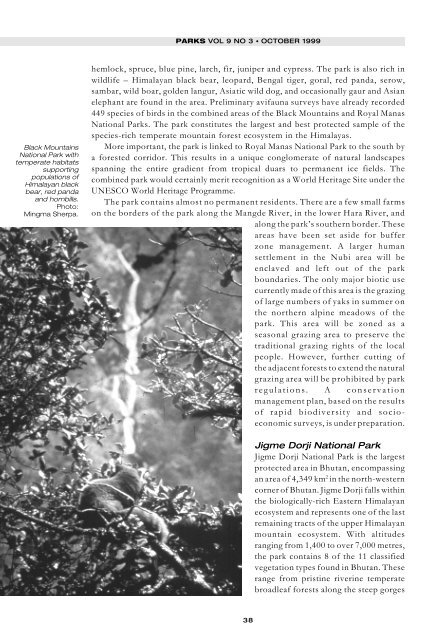Parks - IUCN
Parks - IUCN
Parks - IUCN
Create successful ePaper yourself
Turn your PDF publications into a flip-book with our unique Google optimized e-Paper software.
Black Mountains<br />
National Park with<br />
temperate habitats<br />
supporting<br />
populations of<br />
Himalayan black<br />
bear, red panda<br />
and hornbills.<br />
Photo:<br />
Mingma Sherpa.<br />
PARKS VOL 9 NO 3 • OCTOBER 1999<br />
hemlock, spruce, blue pine, larch, fir, juniper and cypress. The park is also rich in<br />
wildlife – Himalayan black bear, leopard, Bengal tiger, goral, red panda, serow,<br />
sambar, wild boar, golden langur, Asiatic wild dog, and occasionally gaur and Asian<br />
elephant are found in the area. Preliminary avifauna surveys have already recorded<br />
449 species of birds in the combined areas of the Black Mountains and Royal Manas<br />
National <strong>Parks</strong>. The park constitutes the largest and best protected sample of the<br />
species-rich temperate mountain forest ecosystem in the Himalayas.<br />
More important, the park is linked to Royal Manas National Park to the south by<br />
a forested corridor. This results in a unique conglomerate of natural landscapes<br />
spanning the entire gradient from tropical duars to permanent ice fields. The<br />
combined park would certainly merit recognition as a World Heritage Site under the<br />
UNESCO World Heritage Programme.<br />
The park contains almost no permanent residents. There are a few small farms<br />
on the borders of the park along the Mangde River, in the lower Hara River, and<br />
along the park’s southern border. These<br />
areas have been set aside for buffer<br />
zone management. A larger human<br />
settlement in the Nubi area will be<br />
enclaved and left out of the park<br />
boundaries. The only major biotic use<br />
currently made of this area is the grazing<br />
of large numbers of yaks in summer on<br />
the northern alpine meadows of the<br />
park. This area will be zoned as a<br />
seasonal grazing area to preserve the<br />
traditional grazing rights of the local<br />
people. However, further cutting of<br />
the adjacent forests to extend the natural<br />
grazing area will be prohibited by park<br />
regulations. A conservation<br />
management plan, based on the results<br />
of rapid biodiversity and socioeconomic<br />
surveys, is under preparation.<br />
38<br />
Jigme Dorji National Park<br />
Jigme Dorji National Park is the largest<br />
protected area in Bhutan, encompassing<br />
an area of 4,349 km 2 in the north-western<br />
corner of Bhutan. Jigme Dorji falls within<br />
the biologically-rich Eastern Himalayan<br />
ecosystem and represents one of the last<br />
remaining tracts of the upper Himalayan<br />
mountain ecosystem. With altitudes<br />
ranging from 1,400 to over 7,000 metres,<br />
the park contains 8 of the 11 classified<br />
vegetation types found in Bhutan. These<br />
range from pristine riverine temperate<br />
broadleaf forests along the steep gorges

















